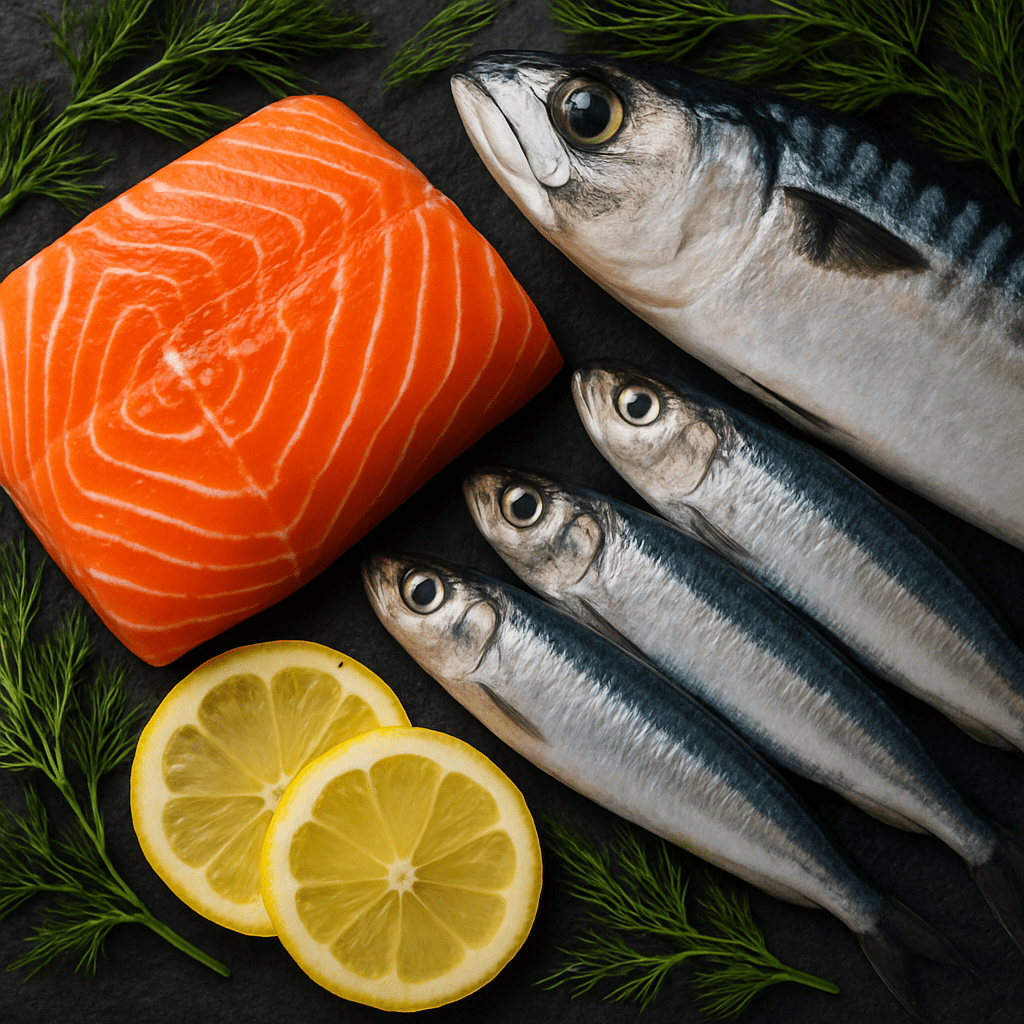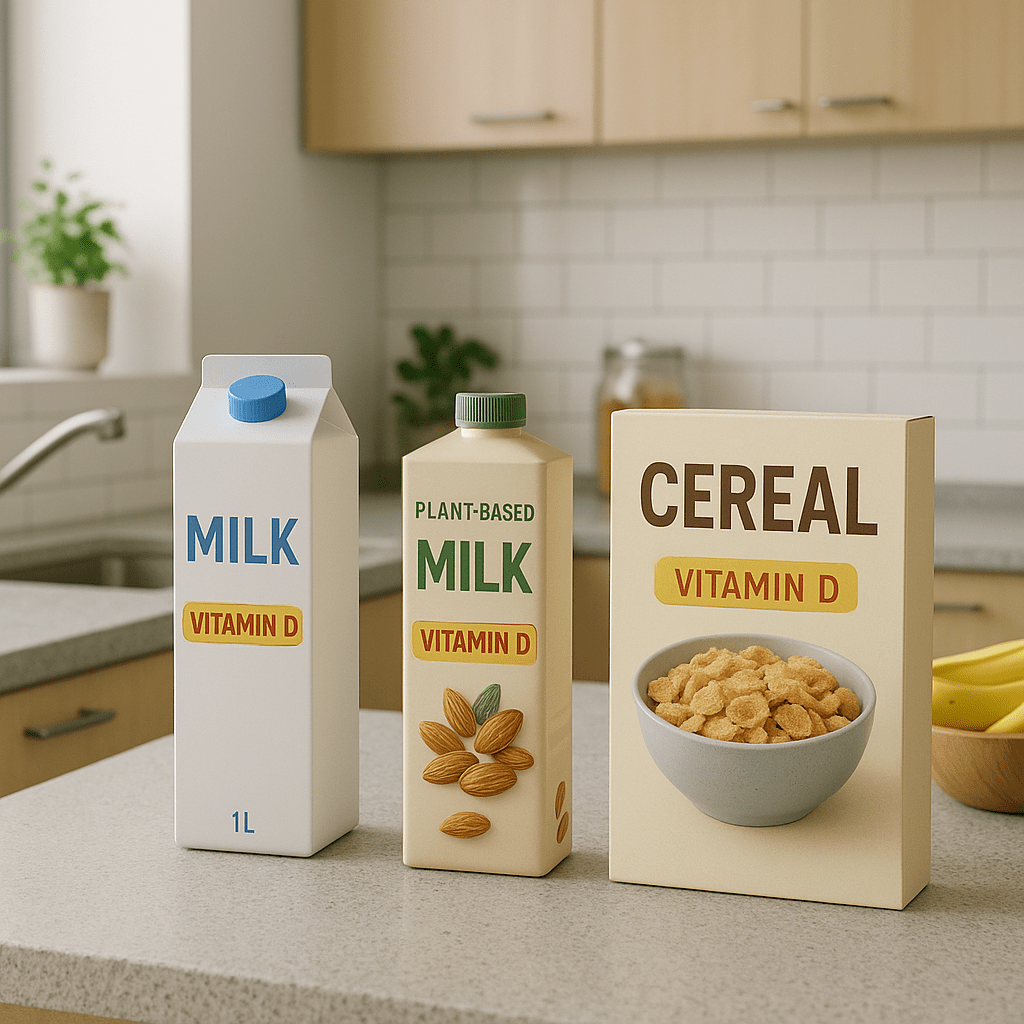Vitamin D is vital for our body – it strengthens bones, improves mood and supports immune system function. Unfortunately, most people, especially those living in northern regions like Lithuania, are deficient in this important vitamin. Since our body produces vitamin D when the skin is exposed to direct sunlight, during the winter months, when the days are short and often cloudy, the body may not have enough of this vitamin. In this article, we will present seven effective ways to increase the amount of vitamin D in the body – both naturally and with the help of supplements. If you want to learn more about the importance of vitamins for the immune system, read our comprehensive guide to vitamins for immunity.
Why is vitamin D essential for our health
Vitamin D performs many important functions in the body. First of all, it helps the body absorb calcium and phosphorus – minerals necessary for strong bones and teeth. Without adequate vitamin D, our bodies cannot use these minerals effectively, which can eventually lead to bone diseases such as osteomalacia in adults and rickets in children.
Studies also show that vitamin D strengthens the immune system, reduces inflammation, and may even protect against certain chronic diseases, including heart disease, some cancers, and autoimmune diseases. It also plays an important role in mood regulation—a deficiency is often linked to depression and mood swings.
The recommended daily allowance for adults is 600-800 IU (international units), or 15-20 micrograms. However, people over 70 are recommended to consume more—about 800 IU (20 micrograms) per day. Those at risk for vitamin D deficiency include the elderly, people with darker skin pigmentation, people who spend little time outdoors, and those who follow a vegetarian or vegan diet.
Vitamin D deficiency can cause fatigue, weaker bones, increased susceptibility to infections, a weakened immune system, and muscle weakness. Long-term deficiency can lead to more serious health problems, such as osteoporosis and chronic pain.
Benefits of Sunlight: The Most Natural Source of Vitamin D
Sunlight is the main source of natural vitamin D. When ultraviolet B rays (UVB) reach our skin, they interact with cholesterol in skin cells and initiate a chemical reaction that forms a precursor to vitamin D. This compound then travels to the liver and kidneys, where it is converted into the active form of vitamin D, called calcitriol.
To get enough vitamin D from the sun, it is enough to spend 10-30 minutes in the sun several times a week. The best time is midday, when the sun is at its highest and UVB rays are most intense. However, the duration of sun exposure depends on several factors: skin pigmentation (darker-skinned people need more time), time of year (UVB rays are weaker in winter), geographical location (in northern regions, such as Lithuania, UVB rays are weaker) and clothing (they block UVB rays).
Although sunlight is the most natural source of vitamin D, excessive exposure to the sun without protection increases the risk of skin cancer. Therefore, a balance needs to be found between sufficient exposure to the sun for vitamin D synthesis and protection of the skin from harmful ultraviolet radiation. It is recommended to stay in the sun for a short time without protection (10-15 minutes), and then use a sunscreen with an SPF of 30 or higher.
It is especially important for Lithuanian residents to pay attention to the lack of sunlight in the winter months. From November to March, UVB rays in our latitudes are too weak for the skin to produce vitamin D, so at this time of year it is necessary to look for alternative sources of this vitamin.

Getting Vitamin D from Food: The Main Foods
While sunlight is the main source of vitamin D, some foods can also be valuable sources of this vitamin. Including them in your diet can help you increase your overall vitamin D intake, especially during the darker seasons. For more information on natural supplements and their role in boosting your vitamin D intake, visit this natural supplements resource.
Animal Sources
Oily fish is one of the best natural sources of vitamin D. 100 g of salmon contains about 400-600 IU of vitamin D, which is about 50-75% of the recommended daily allowance. Other fatty fish such as herring (about 200 IU/100 g), sardines (about 270 IU/100 g), mackerel (about 360 IU/100 g) and tuna (about 230 IU/100 g) are also excellent sources of this vitamin.

Egg yolks also contain vitamin D, although to a lesser extent than oily fish. One large egg yolk contains about 40 IU of vitamin D. While this is not much, eating eggs regularly can help you meet your total vitamin D intake.
Liver, especially beef liver, is also a good source of vitamin D. 100 g of beef liver contains about 50 IU of vitamin D. Liver is also rich in other important vitamins and minerals, such as vitamin A, iron, and B vitamins.
Plant-based sources
Vegetarians and vegans may find it difficult to get enough vitamin D from food, as most natural sources are animal-based. However, there are plant-based alternatives:
Mushrooms are unique in that they can produce vitamin D when exposed to UV light, similar to human skin. Mushrooms exposed to UV light can contain up to 400 IU of vitamin D per serving (100 g). Regular consumption of these mushrooms may be beneficial for vegans and vegetarians.
Fortified foods are another way to increase your vitamin D intake. Many foods, especially milk, plant-based milk alternatives (soy, almond, coconut milk), and breakfast cereals, are fortified with vitamin D. These products typically contain 100 to 200 IU of vitamin D per serving.

Products available in Lithuania, such as fortified milk and other dairy products, some margarines and breakfast cereals, can also be useful in increasing your vitamin D intake. However, it is important to note that even when eating these foods, it may be difficult to reach the recommended daily allowance, especially during the darker seasons.
Vitamin D supplements: when food and sunlight are not enough
While it is best to get vitamin D from natural sources, for many people, especially those living in northern regions, supplements are becoming a necessity. This is especially true during the winter months, when sunlight is lacking and natural food sources may not be sufficient.
Supplementation is especially recommended for certain risk groups. Older people (over 65 years of age) often need higher amounts of vitamin D because their skin produces this vitamin less efficiently. Vegans and vegetarians who do not consume fish, eggs and other animal products are also at risk. People who spend little time outdoors or who always cover their skin for cultural or religious reasons, as well as those with darker skin pigmentation in northern regions, may also be at higher risk of vitamin D deficiency.
There are two main types of vitamin D on the market: vitamin D2 (ergocalciferol), which is plant-based, and vitamin D3 (cholecalciferol), which is usually animal-based. Studies show that the D3 form is more effective at increasing and maintaining vitamin D levels in the blood. Supplements can come in a variety of forms: tablets, capsules, drops, or chewable gum.
Vitamin D dosage should be individualized, depending on a person’s health, age, and other factors. The general recommended daily intake for adults is 600-800 IU (15-20 micrograms), but doctors may recommend higher doses for some people, especially those with established vitamin D deficiency. It is always important not to overdose – too much vitamin D can cause hypercalcemia (high blood calcium levels), which can damage the kidneys and heart.
When choosing a vitamin D supplement, there are a few things to consider. Check that the supplement has quality certifications and is free of unwanted additives or allergens. Also pay attention to the form of the vitamin – D3 is usually a more effective form than D2. If you are vegan, look for specially formulated vegan D3 supplements made from lichens. If you are considering supplements, products like Endoca Natural Vitamin D offer natural vitamin D3 from quality ingredients.
It is recommended to consult a doctor before taking any supplements, especially higher doses.

He or she can measure your vitamin D levels and recommend the most appropriate dose.
Smart Strategies: Seven Ways to Get More Vitamin D Every Day
To make it easier to ensure you get enough vitamin D, here are seven practical ways that include all of the sources discussed above. These tips will help you systematically increase your vitamin D intake every day.
- Spend 10-30 minutes outdoors in the middle of the day. If weather conditions allow, set aside time each day to be outdoors when the sun is at its highest. Remember that even on a cloudy day, some UVB rays can penetrate through clouds. In spring and summer, this may be enough for your daily intake.
- Include oily fish in your diet several times a week. Salmon, herring, mackerel, sardines, or tuna are all great choices. For example, 150 g of salmon can provide almost the entire daily dose of vitamin D.
- Eat mushrooms regularly, especially those exposed to UV radiation. These mushrooms have significantly more vitamin D than regular mushrooms. If you can’t find them, you can make your own by simply exposing them to sunlight for 15-20 minutes before cooking.
- If you’re not vegan, eat eggs regularly. While a single yolk contains little vitamin D, regular consumption can help boost your total intake. Two eggs for breakfast will provide you with about 80 IU of vitamin D.
- Choose fortified products. When buying milk, plant-based milk, or breakfast cereals, look for those that are fortified with vitamin D. These products will usually have clear labels stating that they contain added vitamin D.
- Consider taking a vitamin D supplement to ensure your safety. Especially in the winter, when sunlight is scarce, supplements may be necessary. For those looking for a convenient alternative, vitamin gummies have become a popular choice for daily vitamin and mineral supplementation.
- Get your vitamin D levels checked and talk to your doctor. A regular blood test can show whether you have enough vitamin D in your body. Your doctor can provide individual recommendations based on your health status and needs.
Following these recommendations can help ensure that you have enough vitamin D in your body year-round. It is important to remember that the best results are achieved by combining natural sources (sunlight, food) with judicious use of supplements, especially during the darker seasons.
Let’s summarize
Sufficient vitamin D is essential for our health – it strengthens bones, supports immune system function and improves overall well-being. Especially for those living in northern regions such as Lithuania, vitamin D deficiency can be a real challenge, especially during the winter months.
In order to ensure optimal vitamin D levels, it is recommended to take a holistic approach – combining natural sources such as sunlight and food, with the judicious use of supplements. Sunlight remains the best natural source, so make time to be outdoors whenever possible. Prioritize fatty fish, eggs and fortified products in your diet.
During the winter months, when sunlight is lacking, many may need supplements. Choose a quality vitamin D3, such as Endoca Natural Vitamin D, and stick to the recommended doses. However, always consult a healthcare professional before taking any supplements.
The most important thing is to be proactive about your health. Review your habits, adjust your diet, and consider taking supplements if necessary. Remember that everyone’s needs are unique, so an individual approach to vitamin D intake is most effective.
Frequently Asked Questions (FAQs)
What are the main symptoms of vitamin D deficiency?
The most common symptoms are fatigue, frequent illnesses, bone or muscle pain, depressed mood, and slow wound healing.
How much vitamin D do you need per day?
Most adults need 600-800 IU (15-20 mcg) per day, but needs vary depending on age, health, and sun exposure – talk to your doctor for personal advice.
Can you get enough vitamin D from food alone?
It is possible, but many people in northern climates need a combination of sunlight, diet, and supplements, especially during the winter.
Are plant sources of vitamin D as effective as animal sources?
Plant sources (like mushrooms) provide vitamin D2, which is less potent than the D3 found in animal products and high-quality supplements.
Is it possible to get too much vitamin D?
Yes, taking too much supplement can cause toxicity. Stick to recommended doses and consult a healthcare professional if in doubt.

